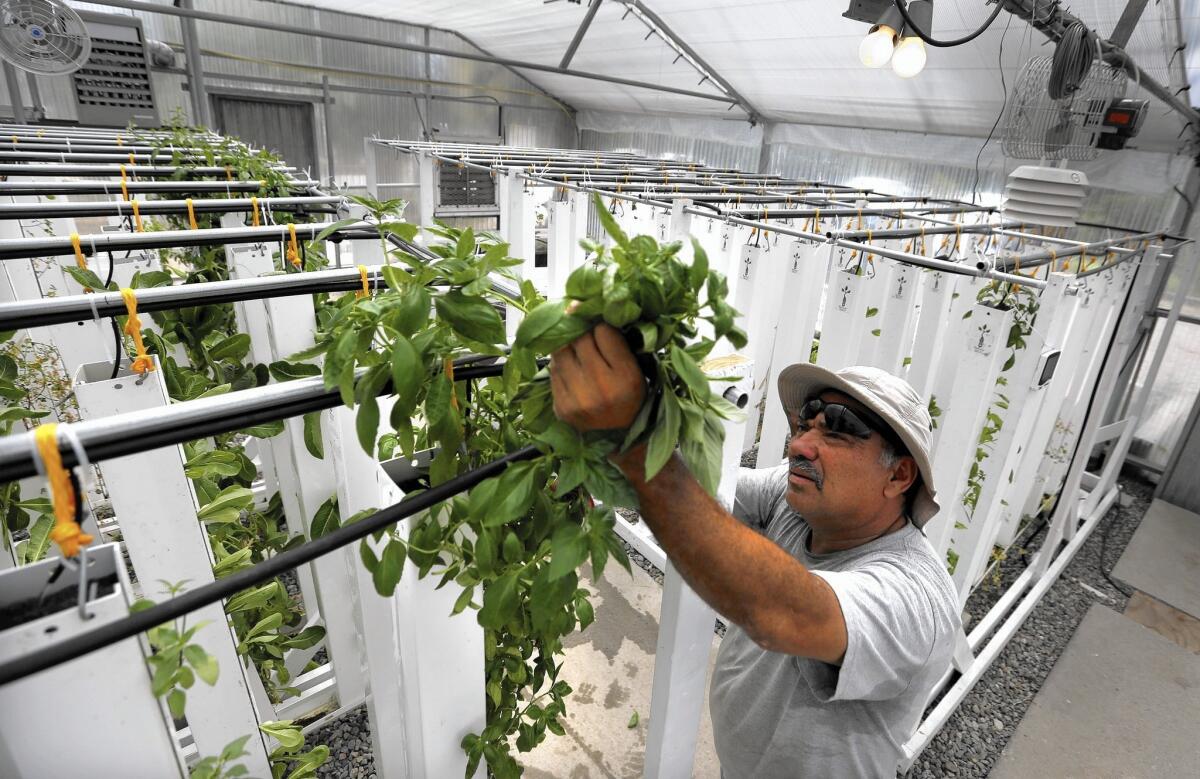Innovation is blooming at water-wise urban farms

As California moves through its fourth summer of drought, cutting back on water use means shorter showers, fuller dishwashers and drier lawns for most people living in urban areas.
But for small farms nestled between city streets, saving water means recycling it — and finding new ways to keep plants alive without wasting the precious liquid.
Unlike the large industrial farms that give California its reputation as the salad bowl of the nation, urban farmers don’t have to let fields sit fallow to reduce water use. The small-scale operations leave room for more creative approaches to drought-friendly growing practices. For those producing and selling food in the city, the drought has provided opportunities as well as obstacles.
“In a way it’s been even good for us because people are more inclined to see we’re doing a good thing,” Jimmy Ng, program director and manager at the Growing Experience in Long Beach, said. “People can see that to some extent and appreciate how much less [water and resources] it takes to get this food to market.”
The Growing Experience grows enough food to supply 15 individual subscribers and a handful of local restaurants with fruits and veggies weekly. Typically, the area’s urban farms try to make a profit, but the Growing Experience plows its proceeds into programs to encourage healthy eating, including workshops and its youth farming project.
Romaine lettuce, watercress, basil, mint and bok choy grow in vertical towers between pieces of sponge-like growing material instead of dirt. The plants are watered through a closed-loop system that pumps water to the top of each column and collects whatever drips down to the bottom to recirculate into large holding tanks. Fish swim inside the tanks, adding nutrients the plants need to survive. Then the water is pumped back up to the top of the towers to trickle down through the plant roots and back to the fish again.
The system, known as aquaponics, uses less water than traditional soil planting because very little water is lost to evaporation and none is absorbed into the ground. Four times as many plants can grow in one square foot because the columns provide extra space for the leaves and roots to spread upward.
Some Los Angeles City Council members hope there will be more urban farms filling their own city’s empty lots in the near future. Councilman Felipe Fuentes said his district has properties that have been blighted for years, but the landowners won’t improve them. Fuentes and Councilman Curren Price have proposed a measure to offer tax incentives for property owners who rent or donate their land for agricultural purposes for at least five years.
Because Los Angeles’ watering restrictions apply only to grass lawns, urban farmers would be able to establish flourishing new gardens.
Not only would these urban farms replace ugly, empty lots, but they also would create community spaces that encourage activity, healthy eating and potential economic growth, Fuentes said.
“These farms speak to a lot of opportunity for Los Angeles,” he said. “They can fortify the nutritional balance of peoples’ lives.”
Locally grown food leaves a much smaller environmental footprint, Fuentes said. The farms use less water and require less gas to transport crops.
Municipalities can place regulations on urban farms — which are often not zoned as agricultural sites — as if the farm were a home or a store. And the water costs the same as the liquid running through the tap at home, which is often more expensive than water specifically allocated to agriculture.
The Growing Experience waters its plants just twice a week because of Long Beach regulations, and it is experimenting with other methods to reduce water use.
In a corner of the 4.5-acre farm, space is reserved for native California and drought-resistant plants. These crops are watered heavily in the first few weeks to anchor roots in the ground and give seedlings plenty of hydration. But for the rest of the season, the plants get water only from whatever rain falls on the lot. The technique is called “dry farming.”
Reduced watering can produce smaller fruits and vegetables than shoppers are used to. But the smaller food is no less tasty, Ng said.
The Growing Experience’s subscribers agree to accept smaller produce in drought years. But when the dry spell breaks, they will be sent larger fruits and vegetables every week, Ng said.
Twitter: @katemshepherd
More to Read
Start your day right
Sign up for Essential California for news, features and recommendations from the L.A. Times and beyond in your inbox six days a week.
You may occasionally receive promotional content from the Los Angeles Times.






